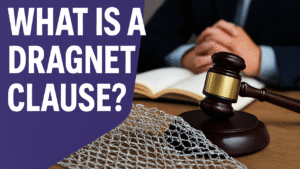 What Is a Dragnet Clause? Everything You Need to Know
What Is a Dragnet Clause? Everything You Need to Know
When navigating real estate or commercial lending agreements, you may come across a legal provision known as a Dragnet Clause. Despite its somewhat ominous name, this clause is a standard—albeit often misunderstood—feature in loan documents. If you’re a borrower, lender, real estate investor, or simply someone interested in financial and legal matters, understanding what a dragnet clause is and how it works is essential.
In this blog post, we’ll explore what a Dragnet Clause is, how it functions, where it’s commonly used, and what both borrowers and lenders should watch out for. We’ll also cover common misconceptions and provide practical examples to make things clear.
What Is a Dragnet Clause?
A dragnet clause is a legal provision found in loan agreements or mortgages that allows a lender to secure not only the specific debt referenced in the loan agreement but also any future or past debts owed by the borrower to the lender.
Think of it as a “catch-all” clause—hence the name “dragnet,” like a net cast widely to catch as much as possible.
In essence, the clause “drags in” other obligations, not just the one that originally triggered the security interest.
How Does a Dragnet Clause Work?
Here’s a simplified version of how a dragnet clause operates:
1. You take out a mortgage from Bank A for \$200,000.
2. That mortgage document contains a dragnet clause.
3. Later, you take out a personal loan or credit line from Bank A for \$50,000.
4. Even though that second loan is unrelated to your mortgage, the dragnet clause allows the bank to treat the collateral (your house) as security for both loans.
5. If you default on the personal loan, the lender can foreclose on the property tied to the mortgage—even if you’re current on your mortgage payments.
Where Are Dragnet Clauses Commonly Used?
Dragnet clauses are typically found in the following:
Mortgages
Deeds of Trust
Commercial Loan Agreements
Lines of Credit
Home Equity Loans
Business Financing Contracts
They’re more commonly used in commercial financing than in residential mortgages, but their use is spreading.
Why Do Lenders Use Dragnet Clauses?
Lenders include dragnet clauses for several reasons:
1. Simplifies Collateral Management: Instead of preparing a new security agreement for each loan, the dragnet clause allows the same collateral to secure multiple loans.
2. Protects the Lender’s Interests: If the borrower defaults on any financial obligation, the lender has legal grounds to seize the asset.
3. Reduces Paperwork: Especially in commercial relationships with ongoing financial activity, a dragnet clause avoids the need for repeated documentation.
Benefits of Dragnet Clauses
For Lenders
Efficiency: Less administrative work.
Protection: Strengthens the lender’s legal position.
Flexibility: Enables ongoing credit arrangements using existing collateral.
For Borrowers
Convenience: May facilitate access to future loans without new collateral.
Cost Savings: Potentially reduces legal and document fees for future borrowing.
Risks of Dragnet Clauses
While dragnet clauses offer efficiency, they also carry risks—especially for borrowers.
For Borrowers
1. Unexpected Liability: A borrower might not realize their collateral secures future debts.
2. Foreclosure Risk: Defaulting on an unrelated debt could still result in the loss of property.
3. Lack of Transparency: The broad language may obscure which obligations are covered.
4. Inheritance and Estate Conflicts: Inherited debts might suddenly become secured by family property.
For Lenders
Legal Challenges: Courts may scrutinize or invalidate dragnet clauses if they are overly broad or ambiguous.
Enforceability: Not all jurisdictions enforce dragnet clauses in the same way.
Legal Challenges and Court Interpretation
Courts often look skeptically at dragnet clauses, particularly in residential real estate. Key issues that arise include:
Was the borrower adequately informed?
Did the borrower intend for the collateral to secure other debts?
Were the additional debts sufficiently related to the original loan?
In some states, courts may require “clear and unequivocal” language for a dragnet clause to be enforceable. Others may limit its application only to debts closely tied to the original purpose of the loan.
Real-World Example
Let’s say Jane takes out a mortgage on her home from ABC Bank. The mortgage includes a dragnet clause stating that the home secures all current and future debts Jane may owe to ABC Bank.
Three years later, Jane opens a small business and takes out a \$40,000 business loan—also from ABC Bank. She defaults on the business loan but continues making mortgage payments.
Because of the dragnet clause, ABC Bank can initiate foreclosure proceedings on her home—even though the original mortgage is not in default.
How to Protect Yourself as a Borrower
If you’re signing any loan agreement that includes a dragnet clause, here are a few protective steps:
1. Read the Fine Print: Look for any language that references “all obligations,” “future advances,” or “other indebtedness.”
2. Ask Questions: Clarify with your lender what exactly the collateral will secure.
3. Limit the Clause: Negotiate to exclude future debts or unrelated obligations from being secured.
4. Seek Legal Advice: If you’re unsure, consult a real estate attorney or contract specialist.
Dragnet Clause: Final Thoughts
A dragnet clause is a powerful legal tool that can significantly affect your financial obligations and risk exposure. While beneficial for lenders and efficient in certain situations, it poses hidden dangers for borrowers who may not fully understand the implications.
Whether you’re a borrower or a lender, taking the time to review loan documents and consult professionals can help you avoid surprises down the line. As always, knowledge is your best financial defense.